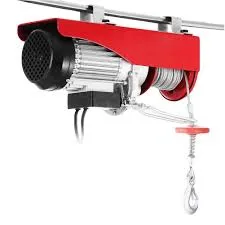


Understanding Lever Hoist Blocks Mechanisms of Lifting and Load Management
In the world of mechanical lifting and load management, few devices are as versatile and indispensable as the lever hoist block. This simple yet effective tool utilizes the principle of leverage to lift heavy loads with minimal effort. Whether in construction, warehouses, or rigging applications, understanding how lever hoist blocks operate can significantly enhance efficiency and safety in various tasks.
What is a Lever Hoist Block?
A lever hoist block, often referred to simply as a lever hoist, is a manual lifting device that employs a chain and lever mechanism to lift, lower, or horizontally move loads. The design typically involves a housing that contains a ratchet and pawl system, a chain that connects to the load, and a lever arm that the user operates. When the lever is pulled down, it engages the pawl with the ratchet to raise the load without requiring electricity or extensive physical strength.
How Does It Work?
At the core of a lever hoist block's operation is the mechanical advantage provided by the lever. The principle of leverage states that a smaller force can move a larger load if the effort is applied at a distance from the fulcrum. In practical terms, this means that by pulling down on the lever arm, the user can efficiently lift loads that may otherwise be too heavy to move manually.
1. Engagement of the Mechanism When the operator pulls the lever down, the attached chain is pulled through the hoist’s body. The ratchet mechanism prevents the load from descending unless the lever is released. 2. Load Lifting As the user continuously pulls the lever down, the mechanism engages the pawl with the ratchet wheel, allowing the chain to draw the load upwards. The design ensures that the load is anchored safely as soon as the lever is released.
3. Load Lowering For lowering the load, the user typically applies a controlled release of the lever, which allows the chain to slip and lower the load gradually.
Advantages of Lever Hoist Blocks

The lever hoist block boasts a multitude of advantages, making it a preferred choice across various industries
- Portability Most lever hoists are compact and lightweight, making them easy to transport and use in different locations. - Simplicity With no complicated electronics to operate, lever hoists can be used by individuals with minimal training. - Versatility They can effectively handle various loads, from construction materials to equipment, making them suitable for numerous applications. - Safety With built-in safety mechanisms, such as the ratchet and pawl, users can lift loads without the risk of sudden drops.
Applications in Various Industries
Lever hoist blocks are widely used in many fields due to their efficient lifting capabilities. In construction, they assist in raising heavy materials like beams and scaffolding. In shipping and warehousing, lever hoists facilitate the movement of goods, ensuring safe handling and better organization. Additionally, in automotive repairs, these devices are invaluable for lifting engines and components during maintenance tasks.
Safety Considerations
While lever hoist blocks are reliable, safety should always be a priority. Operators should adhere to the following guidelines
- Proper Training Users should be trained to understand the mechanics and limits of the lever hoist. - Weight Limits Always respect the load capacity specified by the manufacturer. Overloading can lead to mechanical failure. - Inspection Regularly inspect the hoist for wear and tear, ensuring that all components are functioning correctly. - Environment Ensure that the operating environment is conducive to safe lifting, avoiding obstacles and ensuring adequate footing.
Conclusion
In summary, lever hoist blocks are essential tools for efficient load management across various industries. Their simplicity, portability, and effectiveness in lifting heavy loads make them a staple in many workplaces. By understanding their mechanics and adhering to safety protocols, users can enhance their operations while minimizing risks associated with lifting heavy objects. The lever hoist block exemplifies the blend of engineering ingenuity and practical application, proving that sometimes, the simplest solutions are the most effective.



